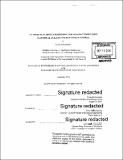Chamber matching in semiconductor manufacturing using statistical analysis and run-to-run control
Author(s)
Haskaraman, Feyza
DownloadFull printable version (10.87Mb)
Other Contributors
Massachusetts Institute of Technology. Department of Mechanical Engineering.
Advisor
Duane Boning.
Terms of use
Metadata
Show full item recordAbstract
This thesis focuses on a chamber matching methodology for semiconductor manufacturing in Analog Devices Inc.'s fabrication sites. As ADI extends its efforts to implement Internet of Things and predictive maintenance (PdM) to its fabrication facilities, it is also seeking to increase their overall yield by implementing better monitoring and control of processes and matching the performance of chambers. This thesis project was conducted by F. Haskaraman, T. Nilgianskul and T. Nerurkar as a team to make a series of recommendations to improve process yields using statistical control and to show the benefits of chamber matching in particular. Nilgianskul's thesis focuses on the statistical process control and Nerurkar's thesis focuses on Design on Experiments (DOEs). A chamber matching methodology is created and applied to chambers that run the plasma-ashing process. Using design of experiments, the machines are modeled individually and globally. While individual models reveal the mismatch, a global model is proposed as a step to optimize the process recipes for matching. The root cause of the differences is diagnosed with instrumented wafers and in-situ sensor monitoring. Recommendations are made to standardize the hardware and software along with calibration methods. First batch of streamed raw data from an in-situ thermocouple is analyzed and found to be another tool to monitor the chamber performance differences. The process is simulated using an EWMA controller and is found to achieve lower mismatch by keeping outputs of the machine closer to the strip thickness in the case of a process drift. At the end of the project, a chamber matching methodology was recommended to the Analog Devices to complement its Internet of Things efforts. By increasing the routing flexibility and decreasing yield variability and tool qualification, this strategy is expected to save significant amount of costs and increase the quality of its products.
Description
Thesis: M. Eng. in Advanced Manufacturing and Design, Massachusetts Institute of Technology, Department of Mechanical Engineering, 2016. Cataloged from student-submitted PDF version of thesis. Includes bibliographical references (pages 79-81).
Date issued
2016Department
Massachusetts Institute of Technology. Department of Mechanical EngineeringPublisher
Massachusetts Institute of Technology
Keywords
Mechanical Engineering.